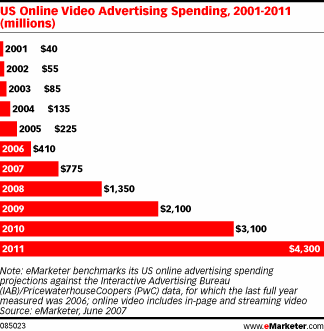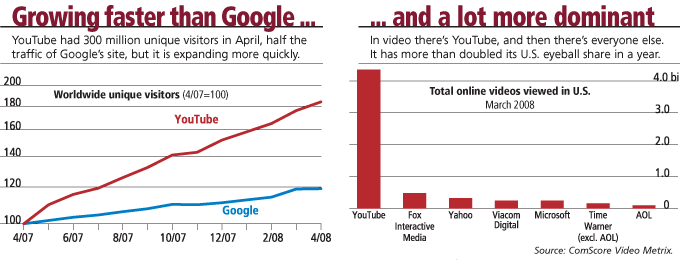If you look at YouTube’s numbers, one thing is clear: It completely dominates online video. YouTube accounts for 37 percent of all videos watched on the Internet and attracts about half of the audience, according to comScore. (And if you add in Google Video, that brings the total to 38 percent of videos watched). The No. 2 player, Fox Interactive Media (i.e., MySpace), accounts for only 4.2 percent of videos watched. And as the Forbes chart above shows, YouTube is still growing at a faster pace in terms of traffic than Google overall.
Yet when it comes to turning that market dominance into dollars, YouTube is holding back. Forbes estimates that YouTube will make $200 million in revenues this year, and $350 million next year. Although it never explains how it gets to those numbers, and they are higher than some Wall Street estimates, they are not unreasonable. (The home page alone is $175,000 a day, plus a commitment to buy $50,000 in Google ads elsewhere—that’s about $80 million a year right there. Plus each branded YouTube channel goes for $200,000. If someone from Forbes can lay out the math in comments, though, that would be helpful). Google does not break out YouTube’s revenues because, even at $200 million, it would be less than one percent of the company’s total.
 A $200 million business going to $350 million is nothing to sneeze at. But if you believe eMarketer’s estimate that online video advertising will reach $1.35 billion this year, that would mean that YouTube’s share of video advertising dollars will only be 15 percent (less than half of its share of videos watched).
A $200 million business going to $350 million is nothing to sneeze at. But if you believe eMarketer’s estimate that online video advertising will reach $1.35 billion this year, that would mean that YouTube’s share of video advertising dollars will only be 15 percent (less than half of its share of videos watched).
This gap could mean one of two things. Either YouTube is unable to make money from a large portion of its user-generated video inventory (advertisers want to stick to the home page and the safety of their own channels). Or YouTube just hasn’t turned on the money-gushing hose yet. It has built an increasingly unassailable market dominance under the shelter of Google’s wing without the need to maximize revenues. That attitude, though, is obviously changing, with YouTube now pushing AdSense for video and spreading that wealth with more content partners.
Which one is it?
YouTube’s Video-Ad Market Share Lags Its Video-Watching Market Share Because . .
( surveys)
